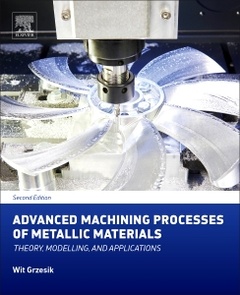Description
Advanced Machining Processes of Metallic Materials (2nd Ed.)
Theory, Modelling, and Applications
Author: Grzesik Wit
Language: English
Subjects for Advanced Machining Processes of Metallic Materials:
608 p. · 19x23.3 cm · Hardback
Description
/li>Contents
/li>Biography
/li>Comment
/li>
Advanced Machining Processes of Metallic Materials: Theory, Modelling and Applications, Second Edition, explores the metal cutting processes with regard to theory and industrial practice. Structured into three parts, the first section provides information on the fundamentals of machining, while the second and third parts include an overview of the effects of the theoretical and experimental considerations in high-level machining technology and a summary of production outputs related to part quality.
In particular, topics discussed include: modern tool materials, mechanical, thermal and tribological aspects of machining, computer simulation of various process phenomena, chip control, monitoring of the cutting state, progressive and hybrid machining operations, as well as practical ways for improving machinability and generation and modeling of surface integrity.
This new edition addresses the present state and future development of machining technologies, and includes expanded coverage on machining operations, such as turning, milling, drilling, and broaching, as well as a new chapter on sustainable machining processes. In addition, the book provides a comprehensive description of metal cutting theory and experimental and modeling techniques, along with basic machining processes and their effective use in a wide range of manufacturing applications.
The research covered here has contributed to a more generalized vision of machining technology, including not only traditional manufacturing tasks, but also potential (emerging) new applications, such as micro and nanotechnology.
Professor of Mechanical Engineering, obtained an M.Sc. in mechanical engineering from the Technical University of Wroclaw, Poland, in 1973, a Ph.D. in manufacturing engineering from this university in 1981, and a D.Sc. (habilitation) in mechanical engineering from Warsaw University of Technology in 1988. From 1973 to 1975 he worked in industry as a design engineer. In 1975 he joined the Technical University of Opole, Poland. He has been a faculty member in the Department of Manufacturing Engineering as Assistant Professor from 1982 to 1988, Associate Professor from 1988 to 1991 and Professor to 1999. At present he is a Full Professor and Chairman of the Department of Manufacturing Engineering and Production Automation at the Technical University of Opole.
He has published more than 140 papers in journals and conference proceedings, two research monographs on metal cutting mechanics and machinability of austenitic stainless steels, and three books on machining of metallic materials, advanced coatings for engineering applications and programming of CNC machine tools. His research interests include the theory and modeling of metal removal processes, monitoring of manufacturing processes, surface integrity, quality engineering and CAD/CAM and modern manufacturing systems.
Currently, he is a Member of two Sections of the Polish Academy of Science, and a Member of ESAFORM and a Senior Member of the NAMRI/SME (U.S.)
- Includes new case studies illuminate experimental methods and outputs from different sectors of the manufacturing industry
- Presents metal cutting processes that would be applicable for various technical, engineering, and scientific levels
- Includes an updated knowledge of standards, cutting tool materials and tools, new machining technologies, relevant machinability records, optimization techniques, and surface integrity
These books may interest you

Fundamentals of Machining ProcessesConventional and Nonconventional Processes, Third Edition 208.65 €

Metal Cutting Theory and Practice 111.58 €

Metal Cutting Theory and Practice 281.07 €

